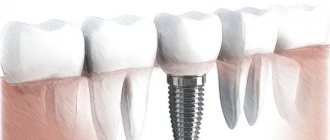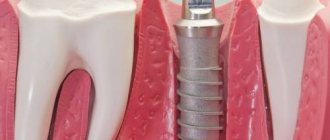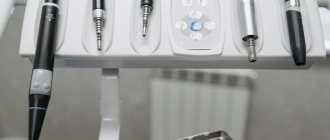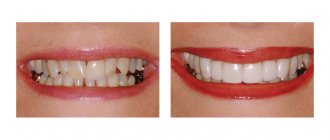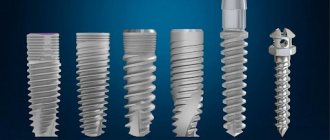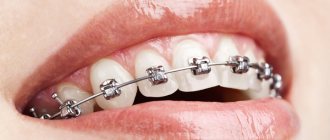28.10.2019
Removing or extracting a tooth is an unpleasant procedure. After the operation, tissue healing awaits. How many days will it take for the sutures to be removed from the gums, what can and cannot be done before and after removal of the sutures - such questions torment patients.
Content:
- Why is the wound sutured after pulling out the figure eight?
- Classification of seams
- How long do you need to walk with non-absorbable sutures?
- How long does it take for self-absorbable sutures to dissolve?
- What complications can you encounter after suturing?
- Recommendations for patients
A dental surgeon applies sutures after removing a wisdom tooth if the intervention was very complex and serious injury to the gums occurred.
Often, specialists insist on suturing a wound, even if it is small, in order to minimize the likelihood of infection. Let's consider what material doctors use when suturing after tooth extraction, whether it needs to be removed in the future, and how to properly care for the injured area.
Why are sutures placed on the gums?
Most often, such a manipulation is carried out when removing a molar or a painful “eight”. In half of the cases, if there are large branches and the nerve is deep, the dentist has to cut the gum. This leaves a large hole or wound that bleeds and can easily become infected. By applying several neat stitches, the specialist tries to prevent possible complications:
- entry of dangerous microbes and microorganisms into the cut;
- improvement of socket fusion;
- decreased blood secretion;
- prevents particles of food and liquid from penetrating into the inflamed area.
Observations and studies show that when suturing an injured gum, the risk of unpleasant consequences is reduced to only 10%. This greatly simplifies daily handling and hygiene. It is important for the doctor to reduce the operated area to a minimum so that pathogenic microflora does not provoke sepsis and periodontal necrosis.
There is a slight difference in what kind of sutures the dentist places on the gums: regular and self-absorbing. The latter are most effective for use in the oral cavity, where there is a large amount of saliva. The optimal material for such work:
- Catgut: has long been used in any field of medicine. It stays well on the mucous membrane for at least 10–14 days. Natural amino acids gradually dissolve the thread and leave no trace. The only problem is the protein base of the material. Some patients experience a negative reaction and even inflammation to this protein, so dentists are using it less and less in their practice.
- Vicryl: a more modern and completely synthetic material that is absolutely safe for the patient due to its hypoallergenicity. It tightly holds the edges of the hole in the required position, is easy to disinfect and retains its properties for 3–4 months. If there is no exact time limit for removing the sutures on the gums, you should not worry: they will definitely dissolve under the influence of moisture.
When a fistula forms on the mucous membrane or a painful lump occurs, only a specialist decides how the operation will be performed and what types of threads need to be used.
Why is the wound sutured after pulling out the figure eight?
Wisdom teeth are very insidious and often lead to serious problems. Pulling it out most often resembles an operation. Since the roots of the unit go deep into the gum and can be ornate, tortuous, soft tissue is often excised to extract them. After all solid debris has been removed from the depths of the tissue, the wound is sutured. This is done in order to:
- prevent bleeding;
- protect the blood clot formed in the wound from injury;
- protect the operated area from the accumulation of food debris;
- minimize the risk of damage to the operating area;
- speed up regeneration processes.
It is believed that applying sutures after wisdom tooth removal reduces the likelihood of infection by approximately 90%. This is explained by the fact that pathogens cannot penetrate into the deep layers of the wound.
Possible complications
Pain and swelling of the gums at rest, difficulty chewing, evening fever in the first two days after surgery and suturing are considered normal - this is a response to surgical trauma. If the symptoms increase, it means that a purulent complication is developing. A visit to the doctor is needed, opening the wound with removal of the suture threads, washing it, re-suturing or draining it, and taking antibiotics.
Complications arise when wound hygiene is not observed, infection occurs, or particles of a tooth or root are left in the wound.
Continued bleeding from the surgical area is possible if the stitches come apart.
Seam divergence
If the suture breaks apart after tooth extraction, this may indicate inflammation of the periosteum - periostitis.
When infected, the wound area swells, there is pain, discharge of pus, which can push out the threads, and the edges of the tissue diverge. Healing is delayed, and there is a risk of developing ugly scars.
If the sutures on the gums come apart, it is necessary to visit a surgeon to determine the cause and eliminate it with re-suturing of the wound in the oral cavity.
Classification of seams
After tearing out the “eight”, at the discretion of the dental surgeon, regular and self-absorbing sutures can be applied.
In the first case, we are talking about materials that cannot dissolve on their own. These are silk, nylon, polyester. Such threads are not absorbed. They securely hold the edges of the wound until the doctor removes them. Self-absorbable material is absorbable. Its main advantage is that the patient does not have to visit the doctor again to have his stitches removed. The latter disappear without a trace on their own.
There are two types of self-absorbable threads:
- Absorbable due to hydrolysis reaction. These include Dexon and Vicryl threads. They are synthetic and do not cause allergic reactions. The edges of the wound are securely held for about one month.
- Absorbable due to the influence of enzymes. We are talking about Catgut. Its particles are quickly eliminated from the human body. Catgut is used for complex dental operations. But it is important to consider that it contains foreign proteins that can cause inflammation.
There is no need to think that suture materials dissolve without a trace. They simply break down into tiny particles that a person spits out or swallows. These particles are non-toxic and therefore cannot cause poisoning.
Types of seams. Types of threads
In each case, when the dental surgeon sutures the gum, he decides which suture to use.
Seams can be intermittent or continuous.
The first type is more common and is characterized by the overlapping of separate, unrelated stitches (pictured below), and each is secured with its own knot.
This maintains the integrity of the fabrics, even if one of the stitches fails and falls off.
There is continuous suturing. All stitches are made with a single suture thread, securing them with a common knot. It's faster, but any damage to one stitch can ruin the entire thread construction.
Absorbable and non-absorbable threads are used to suture the gums.
Sutures that dissolve
Natural (Catgut) and synthetic (Vicryl, Dexon) threads are used. When suturing the gums with Catgut, it can stay on the wound for at least 2 weeks. It is dissolved by saliva substances, but due to its protein base it often causes allergies with inflammation of the gums.
Catgut is contraindicated if there is a high risk of inflammatory complications. Dental surgeons are using this material less and less.
Synthetic Vicryl is safe in terms of tolerability, adheres tightly to the gum, and does not change its strength properties during disinfection. If the doctor does not prescribe a time limit for removing the threads, they will still dissolve within 3 months.
Dexon will last on the gums a little longer than Vicryl, otherwise their properties are similar.
No one can say for sure how long it takes for threads to dissolve in a particular patient. This depends on individual factors: characteristics of the wound, the chemical environment of the oral cavity, general immunity, and the patient’s hormonal status.
When absorbed, the thread does not disappear without a trace, but gradually disintegrates into particles, which are spat out or swallowed by the patient. It is not dangerous to health.
Threads that do not dissolve
Non-absorbable threads are nylon, silk, polyamide fiber (nylon). Synthetic threads are completely hypoallergenic.
Sutures made from non-absorbable sutures are called non-absorbable or non-absorbable sutures. Their removal after the stitches have healed is mandatory. If such threads are used and there are no complications, the surgeon will release the patient from them 7–10 days after the tooth has been pulled out or another operation on the gums has been performed.
How long do you need to walk with non-absorbable sutures?
If the doctor used non-absorbable suture material after removing a wisdom tooth, then seven to ten days later the patient must return for an appointment. The doctor will evaluate how the wound is healing and determine whether the suture material can be removed.
There is no need to be afraid of this procedure. It causes only minor discomfort. The dentist cuts the stitches one by one and, grasping one end of the thread with tweezers, carefully pulls it out. If the patient is afraid of pain, the doctor may use topical anesthesia.
How to care for your gums after sutures are removed
After removing the thread, you should not stop the prescribed treatment. The patient must follow all recommendations of the treating dentist and pay special attention to oral hygiene. Daily cleaning is carried out with a soft brush that does not scratch the mucous membrane. It is important to avoid a sudden rush of blood to the teeth, for which it is better to give up alcohol, coffee and smoking. At this time, a gentle rinsing solution without alcohol is selected.
Every day after each meal, the scar is treated with compounds such as Chlorhexidine, Furacilin or Miramistin. An application with aloe pulp, sea buckthorn or tea tree berry oil is applied to the wound. It is useful to wash the mucous membrane with a warm infusion of calendula, sage or yarrow. If you combine traditional and medical methods, the gums will quickly recover and there will be no trace left of the wound.
How long does it take for self-absorbable sutures to dissolve?
Typically, the suture material disintegrates after three weeks. The patient may notice how it has fallen out, or simply find that the wound remains clean, without threads. In more detail, catgut dissolves from ten to fourteen days, Vicryl - within thirty days, Dexon - a little longer.
It is impossible to name the exact period of resorption. Here everything depends not only on the characteristics of the material used, but also on the individual characteristics of the patient’s body. It also happens that the threads are still in place, but the doctor no longer sees the need for them. Then he removes them in the same way as non-absorbable ones.
Is it painful to remove stitches on the gums?
According to statistics, more than half of people are very afraid of going to the dentist and experience real stress even during a standard filling or professional cleaning of plaque with an ultrasonic device. Therefore, they are concerned with the question: is it painful to remove sutures on the gums? How to remove unpleasant sensations and discomfort?
If the dentist performed the operation correctly and no complications arose, the gums heal quickly. All wounds are covered with a new layer of epithelium and become less sensitive to irritants. Therefore, the doctor calmly removes the remaining suture material. Typically, patients do not experience pain, and the procedure itself takes no more than a minute. People who are panicky about pulling out catgut can ask the dentist to numb the hole by spraying an anesthetic spray (Lidocaine or Novocaine).
If the healing period is difficult and the gums are very achy, the person complains of the inability to chew food normally, analgesics may be prescribed. They are used orally in tablet form using Ibuprofen, Ketanov, Nise or Tempalgin. Gels with a “freezing” effect that relieve tension in the wound are more effective: Dentinox, Dentol, Kamistad or Kalgel.
What complications can you encounter after suturing?
- As a rule, the regeneration process proceeds without complications. But it happens that the patient encounters symptoms that bother him. Let's name the most common complications after wisdom tooth removal:
- Bleeding. In the first three days after surgery, periodic bleeding is considered normal, but if bleeding persists longer, you should immediately consult a dental surgeon.
- Three days after removal, the gums look very swollen and very painful. You need to make sure that all roots have been removed. To do this, pictures of the inflamed area are taken.
- Increased temperature several days after surgery. If the hole bleeds, is swollen and hurts, and the body temperature is elevated, we can talk about inflammation of the surgical area. To remove it, you need to carry out antibiotic therapy.
If you have the slightest doubt regarding the healing process, you should immediately see a qualified dentist. Very often, delay makes the situation worse. It is better to get a consultation once again than to treat an advanced complication for a long time.
When to remove gum sutures
After complex manipulations, the patient should carefully follow all the surgeon’s instructions. Typically, complete healing and restoration of soft tissues takes at least 7-10 days. During this period, the wound and sutures are treated with antiseptics, lubricated with special solutions and ointments to improve blood circulation (Acepta, Metrogyl Denta, Solcoseryl). Sometimes antibiotics are required to treat possible health complications.
The final decision on when to remove the sutures on the gums is made differently in each case. Healing occurs in patients purely individually and depends on age, hormonal levels and general immunity. Threads can be removed if the following positive changes are observed upon visual inspection:
- the mucous membrane is not swollen and has no signs of suppuration;
- the person does not have shooting pain, fever or itching inside the jaw;
- there is no discharge or unpleasant odor from the wound when pressed;
- periodontal tissues have a uniform pink color.
When using self-absorbable material, in most cases the specialist still removes the threads and does not leave them for a long period. If you do this before a clot forms in the socket, inflammation may begin. The dentist will need to open the inflamed area, clean it again, and apply new stitches.
Recommendations for patients
To ensure that the recovery process takes little time and goes without complications, it is recommended:
- Follow all doctor's orders.
- Do not eat anything for the first few hours after surgery. In the first two to three days after therapy, chew food with the healthy side of the jaw and give preference to soft foods.
- Do not touch the unhealed hole with your hands.
- Do not try to remove a blood clot with your tongue or foreign objects.
- Rinse only if prescribed by a doctor.
- Avoid strenuous physical activity for the first two weeks.
- Do not attempt to remove stitches yourself.
By following these simple rules, a person can quickly return to their normal lifestyle after dental surgery.
Why are sutures needed after wisdom tooth removal?
Removal or in medical terms “extraction of third molars” is a complex operation that should be performed not just by dentists, but by specialists in the field of surgery. If the tooth has not yet completely crawled out, but is already interfering with your life, then to remove it you will need to cut the gum.
This is a full surgical procedure performed under anesthesia. Of course, in order to remove the “figure-of-eight”, you will need to cut the tissue, and this leads to the subsequent application of sutures. Sutures promote rapid tissue healing, help cope with the loss of blood clots, and avoid infection.
Does it hurt to remove stitches?
It all depends on the pain threshold and sensitivity of the patient. But usually the wound manages to heal within the specified time; if the doctor works professionally and quickly, then the person does not feel any pain. If sensitivity is high, the doctor may administer a mild form of anesthesia that will calm the patient. During surgery, some people simply do not have the patience to wait for the doctor to remove all the suture fragments.
It happens that the tooth sits so deep that it takes a long time and carefully to remove the threads. In any case, if you want anesthesia, then the doctor, in the absence of contraindications, must agree to give it to you. Another thing is that in free clinics this anesthesia may not greatly affect sensitivity, and you will still feel some discomfort. But everyone has their own choice.
The removal procedure is quite simple: the doctor cuts the threads with special scissors and removes their remains with tweezers. When pus appears, the threads are removed immediately, and then the wound is disinfected and sutured again.
Important! A week after the operation, visit the doctor, but if you feel that the stitches have come apart earlier or that pus has formed, then immediately go to a specialist.
What to do next
The implantation process is quite long. After the threads are removed, the mucous membrane continues to grow over the implant. It shouldn't be visible. This takes approximately two months. Then prosthetics are performed. Installed orthopedic structures require careful care. The patient needs to master the technique of daily procedures that will help maintain a beautiful, healthy smile for a long time. These include:
- using a brush with soft bristles;
- brushing teeth twice a day;
- flossing;
- cleaning the areas where the implants come into contact with the gums using an irrigator;
- If plaque has formed, visit the dental office to remove it.
Patients who have undergone implantation should periodically visit specialists. This will help extend the service life of structures and avoid complications.
Withdrawal deadlines and important factors
The sutures must be removed in time, when the wound has healed securely. If the procedure is performed early, the wound may open. If you remove the threads too late, inflammation will begin. Only a doctor can accurately determine whether or not the sutures can be removed.
The approximate timing for suture removal is given below:
- face/neck – 6-8 days;
- abdomen and chest – 10-14 days;
- after amputation – after 12 days;
- legs/arms – 9-11 days;
- after caesarean section – 7-11 days.
In the mouth they are removed after 3-6 days, and permanent sutures are placed on other mucous membranes.
When removing sutures, it is necessary to take into account a number of factors that will affect the entire process: the age and well-being of the patient, the characteristics of the disease and possible complications, the nature of the operation and the recovery characteristics of the body. For example, you are unlikely to be able to remove the sutures in your mouth without causing more harm.
What to do if the suture breaks after implantation
There are times when the threads have weakened and come apart. This does not threaten the implant falling out, but there is a risk of infection . The situation must be corrected urgently.
After the examination, the doctor will take the necessary antiseptic measures and prescribe rinses. The recovery period after long complex operations is sometimes accompanied by antibiotic therapy. The rehabilitation course for each patient is compiled individually. If the tissues have not yet fused, the specialist will have to remove the stitches and then apply new ones.
Important questions about dental implants
Will I get natural and beautiful teeth? It seems to me that the crowns will be noticeable in any case.
Implants are artificial roots for crowns, dentures and other orthopedic structures.
Thanks to them, the teeth feel like real ones, receive adequate physical activity, and do not move. Installation of a bridge does not require damage to adjacent healthy teeth. As for the aesthetic side of the issue, not a single crown or prosthesis is finally attached before the patient accepts its appearance. We offer each client an individual solution, taking into account requirements and wishes, trying to choose the ideal shape and color scheme. The dentist tries on the finished crown or prosthesis and only after the patient’s consent securely attaches it to the implant.
How many doctor visits are required?
It all depends on the individual factors of the clinical case. As a rule, one consultation is enough to decide on the type of operation and its volume. Then you need to take tests and accurately determine the date of installation of the implant, the type of anesthesia and many other nuances. The actual surgical intervention is performed once, very rarely twice. Then after a few days the situation is controlled, and after 10 days the stitches are removed. The healing period does not require visits to the dentist, but only if it progresses adequately.
Can I exercise after getting implants?
In general, it is not prohibited to move without overload, but you need to wait at least 2-3 weeks after the operation. It is recommended to discuss the issue with your dentist in advance to determine the acceptable type of sport and optimal loads.
What care is required for crowns installed on implants?
Care for artificial teeth in the same way as before for real teeth. No additional tricks are required. Choose a suitable toothbrush and toothpaste, clean the crevices between the teeth and the junctions with the gums. Use dental floss to remove food debris between your teeth. Do not forget to visit the dentist 1-2 times a year for preventive purposes.
Can installed implants cause an allergic reaction?
There are no known cases of allergic reactions to titanium structures in medicine. This material has long been used in traumatology, dentistry and other industries, as it is not rejected by the body. Titanium implants are additionally covered with protective layers and perfectly imitate a real tooth root. Therefore, the occurrence of allergies is impossible.
Will I have any pain after surgery?
The presence and severity of pain depends on the individual characteristics of the body. Some patients do not require analgesics the very next day after surgery. However, pain will definitely occur if you refuse to take medications prescribed by your doctor according to the regimen. You can find a list of them and admission rules in the NB-After card. The necessary medications are in a special white bag.
Can implantation be performed on minors? What age is considered optimal?
Implantation is permitted and is carried out only after the formation of the osteoarticular apparatus of the jaw is completed. As a rule, this occurs by the age of 18, but in individual cases it is delayed for longer periods. Therefore, implantation is definitely not performed on minors. And the possibility of its implementation in older patients is determined using radiographic examination.
When may it be necessary to restore alveolar ridge bone tissue?
In 90% of cases, patients require bone grafting because the jawbone is thinned and is not suitable for implantation. There are plenty of reasons for this: long-term absence of a tooth, low loads on the bone, inflammatory processes, prolonged wearing of any dentures (only implants stop the process of bone resorption).
There is no need to be afraid of bone grafting, because modern technologies have eliminated any risks associated with it. In addition, the restored bone volume guarantees adequate fixation of the implant.
How long will the implant last?
A correctly installed high-quality implant is an ideal imitation of a tooth root. It withstands chewing loads, does not become loose, and does not become less reliable. Implants do not have to be replaced throughout your life, so they are the optimal solution for restoring teeth. It is better to place an implant once than to constantly change removable dentures.
Will I have to go without teeth while the treatment and healing process takes place?
Of course not. If you wore a removable denture before getting an implant, you can put it back almost immediately after surgery. In other cases, the doctor individually selects a temporary prosthesis. Sometimes removable temporary structures are installed for long-term wear. They are attached directly to the implant.
I had surgery and was sent home. What should you do right away?
The first few hours after installation of the implant, you should cool the cheek externally to prevent or at least reduce the severity of swelling. To do this, prepare ice cubes or cold compresses. Recommendations for the postoperative period are written down in the NB-After card. Read it carefully and follow the instructions exactly.
What are dental crowns made of?
Most patients get structures made of metals coated with ceramics to match the color of the teeth. Such structures are strong, reliable and indistinguishable from real teeth. Only when exposed to direct rays of light will the metal inside be visible. Solid ceramics are also used for crowns without the use of metals. It gives the perfect aesthetic appearance to your smile. It is used for both individual crowns and bridges.
What to expect from a consultation?
An initial consultation with a dentist is not something super special. The doctor will assess and discuss your situation, conduct an examination of the oral cavity, suggest the best ways to solve the problem, and prescribe a series of studies. Come to your consultation with old dental photographs, if available. Bring all medical documentation. Don't forget to tell your doctor about your chronic diseases and list the medications you take regularly. Be sure to report any allergies to medications. Don’t be afraid to ask provocative and simply clarifying questions, don’t be afraid to demand certificates and licenses.
I want to get implants, but in the future I plan to lighten my teeth and improve their aesthetic appearance. What should I do?
Feel free to contact our specialists with this problem. Yes, implants are matched to the color of the patient’s tooth enamel. However, our doctors can lighten the teeth using special plates called veneers. They will not only improve the color of your teeth, but also correct cosmetic defects in their shape.
Should smokers get implants?
Previously, smokers were dissuaded from undergoing implantation, since it cost a lot of money, and the result quickly returned to zero due to constant smoking. Modern technologies and materials reduce the risk for smokers and the long-term service life of implants and crowns on them is reduced only with insufficient oral hygiene. If you are concerned about the appropriateness of implantation, discuss this issue with your dental hygienist. He will select individual procedures.
How and when are crowns placed on implants?
In modern conditions, permanent crowns are placed after implants have healed, which occurs within 3-4 months. Duration varies slightly. The process itself consists of: removing temporary crowns, removing a sealed plug, making an impression and shaping the gums using special caps. The dental laboratory creates an individual crown for each patient. Then the fitting takes place and only after this the crown is securely fixed. It happens that you have to adjust the size and shape of the crowns several times so that they do not differ in any way from real teeth.
Are implants placed after tooth extraction?
Certainly. This treatment option is considered one of the most optimal, since the bone tissue does not have time to dissolve. With this type of implantation, bone grafting is often not required. The titanium structure is fixed into the socket from which the real tooth was removed. Further engraftment and further fixation of the crowns proceed as standard.
Do not confuse implantation after tooth extraction and implantation with immediate loading.
What is immediate loading implantation?
In rare cases, when the patient does not undergo bone grafting or, according to individual indications, the operation is performed with immediate loads. That is, a high-quality permanent crown is fixed to the implant immediately after its installation. There is no need to wait until engraftment occurs.
Do I need to remove removable dentures attached to implants before going to bed?
No need. Any crowns or complete removable dentures are very securely fixed to implants, so there is no need to remove them at night. People usually remove their dentures before going to bed to prevent them from shifting and blocking their airways. Dentists always warn patients about this risk. However, technologies for fixing prostheses on implants have eliminated this problem. Therefore, you can sleep peacefully in dentures without risk to health and safety of structures.
How do implants differ from each other in terms of quality?
Implants come in different types and types, depending on the method of implantation. However, the most optimal, safe and predictable option is the classic installation of titanium structures. In appearance, the patient will not be able to distinguish one implant from another, since they are all similar to an ordinary screw. But professionals know that there is a difference in quality.
Modern Nobel Biocare implants are manufactured using a special coating that accelerates bone growth and implantation of the structure. Our clinic only uses implants with a coating that is invisible to the human eye. We have been using Nobel Biocare implants with TI-Unite surface for over a decade and have never been disappointed with their quality.
Is implantation performed under general anesthesia? What kind of anesthesia is used for dental implantation?
No, general anesthesia is not performed. There is no pain or discomfort at all when implantation is performed under local anesthesia. The patient may feel slight vibration or pressure, but no pain. For those people who are terrified of surgical interventions and want to undergo general anesthesia, it is recommended to consult with the treating dentist. He will assess the possible risks and help the patient make the right decision.
I want to change the prosthesis, which is fixed to the implant. Can this be done?
Yes. Whenever. Any dentures or crowns that are attached to implants can be replaced or updated. Moreover, a single implant can be converted into a support for a bridge at any time. The designs used in our clinic are compatible with various individual orthopedic solutions.
Are there diseases for which implantation is prohibited?
There are no specific diseases that would become an obstacle to implantation. However, there is such a thing as the general condition of the patient. If you have serious chronic diseases and they are decompensated, there is organ failure, then no one will perform an operation on you. Only after the condition has stabilized.
When contacting an implantologist to install titanium structures, be sure to inform him about the presence of any pathologies in the body. The doctor will be able to prescribe additional medications and eliminate possible risks. Do not hide the characteristics of your body from the dentist, because this will only increase the chance of an unfavorable outcome of treatment.
Is implantation performed in patients with diabetes?
Yes, it is carried out. However, only after specially corrective treatment aimed at achieving compensation for the patient’s general condition. A similar adjustment can be made in our clinic. Patients with decompensated diabetes mellitus, high sugar levels, and severe complications first normalize their condition and only then can count on implantation. Such precautions are due to the fact that in patients with high sugar levels, wounds heal poorly and the risk of infection is increased.
Can the implant become inflamed and what should I do?
Yes, indeed, in the absence of regular oral hygiene or when immunity is reduced, an inflammatory process can occur. If you consult a dentist in time, then there will be no problems with his treatment. And with regular preventative visits to the doctor, proper brushing of teeth and a generally healthy lifestyle, there is no need to worry about such a problem.
What complications are there?
Previously, complications did occur and not as rarely as we would like. But modern technologies for installing implants and planning surgery make it possible to eliminate all possible risks. The only problem that periodically arises is insufficient fixation of the implant in thinned bone tissue. But the complication, as a rule, is provoked by patients’ refusal to undergo bone grafting. In such cases, the implant is moved under local anesthesia.
I wear a removable denture for the entire jaw, which is constantly moving. I want to install implants, but attach an existing prosthesis to them. Can this be done?
For reliable fastening of a complete removable denture, four titanium structures are sufficient. Your denture can be placed on implants if it is comfortable for biting and chewing and will also provide your jaw with adequate exercise. The fastenings on the implants are so strong that you can immediately forget about displacements. To evaluate the condition of your jaws, your dentures and make the right prosthetic decision, consult with our dentist.
Will I be able to feel which teeth are real and which are not?
No. Implants and modern dentures make it possible to achieve a perfect imitation of natural teeth. You won't feel any difference when you smile, bite into an apple, or chew your food. Only professional dentists can notice the differences, and sometimes only with the help of special equipment.
Are there any dietary restrictions?
No. Implants with crowns, bridges or any other structures attached to them can withstand standard chewing loads without any problems. That is, you should not open a bottle with your teeth - even a natural tooth will not withstand this. But you can eat solid foods like apples or nuts with complete peace of mind.
After surgery, is it preferable to sit or lie down?
We are all accustomed to the fact that after surgery we need to lie down for several days or at least hours. However, in dentistry the situation is the opposite. The horizontal position promotes a rush of blood and lymph to the head, which causes severe swelling and increased pain. Therefore, it is better to spend the first hours after implantation sitting. A short walk in the fresh air will also be beneficial. But don’t overwork yourself – physical activity is prohibited. And try not to bend over.
How soon can you eat and drink?
If you feel thirsty, be sure to drink water at room temperature. However, food and other drinks should be delayed until the local anesthesia wears off. The precaution is due to the fact that the patient may unintentionally damage the wound surface or burn the mucous membranes.
What to eat after surgery?
Eliminate from your diet hard, sticky, floury foods that take a long time to chew or their remains stick to the mucous membranes of the mouth. You can eat light soups, soft cutlets, mashed potatoes. Food should require a minimum of chewing movements. But no yogurt! We also exclude sweets for the first time. You need to eat such food before the stitches are removed, and then you can return to your usual diet.
They say that after installation of implants you should not drink coffee. This is true?
Coffee lovers can safely continue to drink it after implants are installed. You should avoid drinking it, as well as strong teas and highly carbonated drinks, in the first days after surgery. These drinks increase blood pressure, which can cause bleeding.
Is it allowed to chew on the side of the installed implant?
Until the stitches are removed, it is prohibited! Don't be afraid if food gets on the wound. After finishing using it, you should carefully rinse your mouth with warm water each time. However, you need to chew exclusively on the healthy side.
When can I brush my teeth?
A day after surgery, feel free to start brushing your teeth. Moreover, you must start cleaning them to prevent inflammatory processes. When cleaning, walk around the wound surface. It is recommended to use a soft brush so that accidental contact with the bristles on the wound does not damage its edges and seams. The use of irrigators and any mouthwash is prohibited. You should also avoid using an electric toothbrush for a while.
Will there be pain after the local anesthesia wears off?
Yes. The first hours and even days after surgery will help you with a regular analgesic. Take it strictly as directed. The first night after surgery, sleep on a high pillow to allow blood and lymph to flow away from your head. The intensity of the pain syndrome depends on the scope of the operation and the individual characteristics of the body. But gradually the pain will go away. Some clients do not take painkillers within 24 hours after surgery.
Is the wound highly sensitive?
No, and every day the sensitivity decreases. To avoid causing pain or irritation, do not touch the wound with your tongue or fingers. Healing is very fast.
What to do if blood flows?
In the first days after surgery, slight bleeding may persist. It is considered physiological and does not require any action on the part of the patient. Saliva may be slightly pink in color. But the bleeding quickly stops and is almost invisible to patients. If blood flows unexpectedly a few days after the operation, and before that everything was fine, you should immediately consult your doctor.
How long does it take for stitches to be removed?
The date for suture removal is determined individually by the implantologist and depends on the extent of the surgical intervention and some other factors. On average, sutures are removed after one to two weeks.
What do you do after the stitches are removed?
Nothing at first. The next stage is carried out after 5 weeks - the patient is fitted with a gum former. After this, an individual crown or bridge, or a prosthesis for the entire jaw, is made on the implants.
Will the healing abutment interfere?
It will be noticeable in the mouth, but will not cause serious discomfort. Patients usually get used to its presence within a few hours. In addition, they do not wear it for long.
Why is it worth paying attention to the connection between the crown and gums?
This area is the best place for bacteria to penetrate into the gums and even bone tissue. This is accompanied by the occurrence of serious inflammation, which, if the process is neglected and there is no correct treatment, can even lead to the loss of the titanium structure. It is especially important to thoroughly clean the joints in the first year after surgery, when the implant is actively healing.
Are irrigators necessary for proper care?
Until the wound heals and the stitches are removed - definitely not. In general, there are two sides to the coin: irrigators can clean the oral cavity well, but their excessive use can lead to damage to the gums and the penetration of bacteria into it. If you are used to using irrigators, continue, but don’t overdo it! And if you have never used them, then there is no need to start.
Can I use whitening toothpastes?
Yes, but not often. The substances it contains have a very aggressive effect on the crown, which leads to damage to its surface. Consequence: rapid discoloration, accumulation of bacteria, formation of tartar.
Can an unexpected reaction occur if I take medication regularly?
Yes. Cases of cross-reactions are known, so you should list to your dentist all the medications that you have to take on a regular basis. This is especially true for drugs that reduce immunity and blood thinners.
When can I return to work after surgery?
As a rule, you can return to work the next day. But this issue is discussed individually with the dentist. If there is significant swelling, then it is better to sit at home for a day.
How much money will you have to spend?
Our clinic uses a turnkey package implantation system. Its cost will be from 60 thousand rubles . The price of crowns and prostheses is determined individually and depends on the fixation option. In general, the average cost of crowns in Moscow is from 35 to 55 thousand rubles.
What is a batch system?
We offer a fixed price for turnkey implantation, which includes a number of necessary surgical steps. That is, the clinic does not have separate price tags for crowns, anesthesia, and so on. After assessing the clinical case and determining further tactics, the dentist names one amount that will include all stages of treatment. Price includes:
- Cost of the implant itself;
- Cost of the operation, including sterile instruments and consumables;
- Cost of bone grafting and materials for it;
- Applying and removing sutures;
- Control visits to the dentist and necessary examinations;
- The second stage, which includes anesthesia and installation of the shaper.
After this, a crown or prosthesis is selected, which are paid separately.
What is Nobel Biocare?
Nobel Biocare designs are high quality implants. During their production, starting with the supply of materials, each stage is certified and strictly controlled. The design of the implants is clearly calibrated, and their range will allow you to choose the best option even in the most difficult clinical situations. The implants have a specific TI-Unite surface, which is similar in composition to the dentin of natural teeth. This allows for faster healing and increased reliability of implant fixation in the bone.
I have bruxism. Is it possible to get implants or does it make no sense?
Can. In addition to the fact that the implants can withstand standard chewing loads, and the crowns are made of very durable materials, patients with bruxism are recommended to use special mouth guards. They will help reduce stress on your jaws, teeth and joints. Consult with our dentists how best to solve the current situation.
What care is required for dentures and implant crowns?
Care for bridges, crowns, and other dental restorations just as you would for natural teeth. Clean them twice a day, use dental floss, and periodically visit the dentist for preventive purposes. The only point: when brushing your teeth, pay special attention to the spaces between the teeth and the places where the crown comes into contact with the gum.
Is it possible to perform implantation with increased pressure?
Hypertension is a very common pathology. If your treatment regimen for the disease has been completely adjusted, and your blood pressure numbers remain in the same range, then there will be no problems.
How to care for your gums after having a retainer installed?
A short time should pass between the formation of the gums and the placement of the crown. During this period, no special care products are required. It is recommended to brush the area with the former in the same way as you would your teeth, but use a soft brush. Sometimes the doctor puts stitches that are better avoided. The shaper must be completely motionless. If you feel any changes in its location, consult a doctor immediately. Don't try to fix the situation yourself.
Is it possible to do without bone grafting?
Many patients are afraid of sinus lifting because of the imaginary complications that the Internet promises. However, modern techniques for carrying out the procedure have eliminated any risks. Deficiency of the alveolar ridge of the upper jaw occurs in almost all clients, and bone grafting is the key to reliable fixation of the implant.
Can I use an electric toothbrush after implantation?
Certainly. An electric toothbrush cleans your teeth just like a regular toothbrush. Therefore, implantation is not a contraindication for its use.
How often should you visit the dentist after implantation?
If all stages of treatment are completed successfully, then it is recommended to undergo preventive examinations of the oral cavity 2 times a year or at least 1 time a year. This allows you to identify problems at the initial stages and avoid complications.
What are the contraindications for implantation?
There are no absolute contraindications to surgery. Any problem can be solved. But implantation is postponed during pregnancy and lactation, acute inflammation in the oral cavity, and severe decompensated chronic diseases. First you need to carry out corrective treatment, and then proceed with implantation.
Are healthy teeth damaged when dental bridges are installed?
No. Fixing bridges on implants avoids grinding down healthy teeth, which is a definite plus. In addition, implant-fixed dentures and crowns help restore physiological stress to specific areas of the jaw, making healthy natural teeth last longer.
